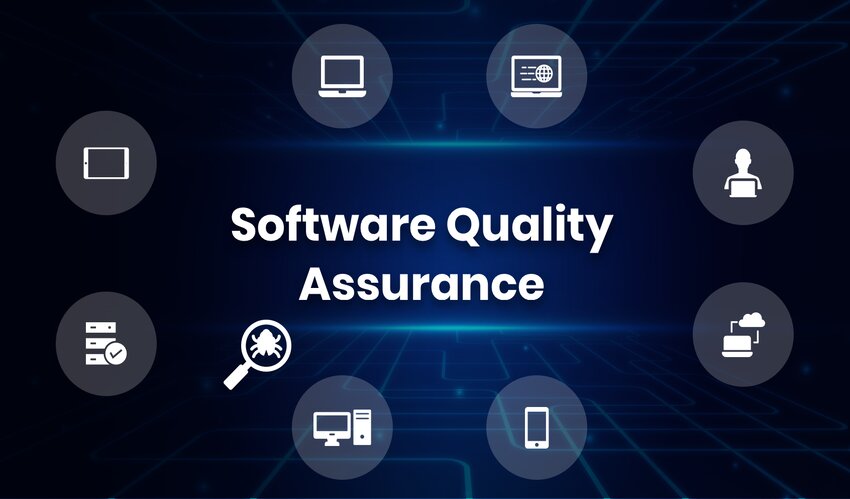
A crucial part of software engineering is to ensure the software is error-free or runs as per specifications. As a result, software quality assurance in software engineering is one such parameter that ensures it. The process ensures trustworthy software by using various techniques and tools.
The significance of QA in software development is now more than ever. Furthermore, it ensures software complies with the standards specified. Additionally, detecting bugs early saves a lot of money for organizations, which in turn makes the entire process flawless.
Therefore, in this blog, we will uncover software quality assurance in software engineering in depth. Not only this! We will look at the process, challenges, and much more. So, let’s get started!
Types of software quality assurance in software engineering
Given that software testing has many facets, it is important to understand the different types of software testing. It aids in generating significantly more effective outcomes.:
- Functional testing
This type of testing guarantees that the program complies with the specifications. The testers concentrate on things like interface, data processing, and system interactions. As a result, your software is faultless.
- Non-functional testing
Apart from functionality, other elements are the focus of this examination. Therefore, it includes testing for performance, security, and usability. It thereby checks the software in various settings. Additionally, it guarantees peak performance.
- Unit testing
Unit testing is the main safeguard against defects. The validity of each core function is verified by the developers. As a result, it tests each component to ensure that it functions as planned. The testing of software quality assurance in software engineering helps identify and fix bugs at an early stage of development.
- Integration testing
Integration testing checks how different modules work together within the software. It guarantees smooth interactions between various components. So, it avoids integration-related problems when integrating various sections of code.
In the various types of testing, what role does a software quality assurance engineer play? Let’s find out the answer to it.
What is the role of a SQA engineer in software testing?
The role of SQA engineers is significant in software engineering. They thoughtfully design tests to cover all necessary material. Additionally, they monitor the specifications to make sure they satisfy the expectations of the consumer. Not only restricted to this! Additionally, they create extensive test cases, pinpoint issues, and record each minute but crucial information, such as the severity of the circumstance.
Additionally, after going over and resolving the problems, they verify and double-check to see if any new mistakes have appeared. SQA engineers examine and evaluate the software’s performance in a variety of settings as part of the testing process. This aids them in identifying issues with the product’s functionality and user base.
So, moving forward, let us now look at the actual process of software quality assurance in software engineering.
How does SQA in software engineering work?
The process of QA in software development involves several key steps:
- Planning
Specify the tests in a complete software engineering strategy. Instructions on how and when to conduct testing should also be included. It ensures that quality assurance activities are properly organized as a result.
- Requirements analysis
Examine the project requirements with great care. The purpose of this is to guarantee that testing efforts are in line with the user’s expectations.
- Resource allocation
Give the resources they require. It entails the hiring of qualified employees, controlled testing settings, and testing equipment. So, the SQA procedure must, therefore, be well supported.
- Test design
Create detailed and well-defined test cases, test scripts, and test data. As a result, it serves as the blueprint for executing tests effectively.
- Test environment setup
Configure a controlled testing environment that mirrors the production setup. As a result, it enables accurate replication of real-world conditions.
- Test execution
Methodically execute the prepared test cases for software quality assurance in software engineering. Moreover, rigorously evaluate software functionality and performance.
- Defect identification
Identify and meticulously document defects. Furthermore, categorize them based on their severity and potential impact.
- Issue tracking
Utilize defect tracking tools to efficiently manage and monitor the resolution of issues. As a result, it ensures that problems are addressed promptly and transparently.
- Regression testing
After resolving defects, perform regression testing. It is to confirm that the fixes have not inadvertently introduced new issues.
Now, to execute the process of software quality assurance in software engineering, you need some tools. So, let us look at a few of them ahead.
What are the tools used for SQA in software engineering?
For software quality assurance in software engineering, having the right set of tools is paramount. Moreover, these tools empower SQA teams to detect defects early and ensure that software meets high-quality standards. So, let’s take a look.
TestLink and TestRail facilitate effective management and organization of test cases. As a result, they generate reports with unmistakable insights and track the development of test case execution.
- Bug tracking tools
Two crucial tools for software quality assurance in software engineering are Jira and Bugzilla. They manage and keep an eye on software defects to effectively prioritize issues and ensure prompt repairs.
- Automation testing tools
Through the use of Selenium, Appium, and JUnit, routine test cases are automated. It is carried out to speed up testing and guarantee uniformity. Additionally, these instruments are required to preserve the efficacy and precision of testing.
- Continuous integration (CI) tools
Examples of software development and deployment automation tools are Jenkins and Travis CI. As a result, they support continuous integration practices by promptly delivering feedback on code modifications.
- Performance testing tools
Utilizing tools like JMeter and LoadRunner, software performance is evaluated. Additionally, they spot areas for improvement and bottlenecks, which leads to the best program performance.
- Security testing tools
The use of OWASP ZAP and Nessus is crucial for locating security flaws. So, these resources increase the software’s resistance to potential dangers and breaches.
Let us now look at the challenges the process can show you. Knowing these challenges will help you deal with them more smartly. You can also overcome these challenges with software testing services. So let’s see.
What are the challenges of SQA in software engineering?
Software quality assurance teams face a multitude of challenges. This is in their pursuit of delivering reliable and high-quality software.:
- Evolving requirements
Changing project requirements can disrupt testing. Therefore, SQA teams must adapt quickly to maintain accurate testing. So, regular communication with stakeholders is essential to address evolving needs.
- Resource constraints
Limited people, time, or test environments can limit quality assurance. Hence, balancing thorough testing with limited resources is a constant challenge. Furthermore, prioritizing testing efforts is critical to make the most of available resources.
- Complex software architectures
Complex software structures need specialized testing methods and tools. SQA teams must stay updated on these complex structures. Moreover, complexity can hide defects and make test coverage challenging.
- Testing across multiple platforms
Ensuring compatibility across different devices and systems needs careful testing. Test environments must mimic real-world conditions across diverse platforms. So, successful cross-platform testing needs a diverse skill set within the SQA team.
- Rapid development cycles
DevOps and Agile call for quicker testing. It’s challenging to meet tight deployment deadlines without sacrificing quality. So automation and continuous testing are essential for sustaining rigorous testing.
- Data privacy and security
Security regulations must be followed, while sensitive data must be kept secure. Although they increase testing complexity, anonymizing and encrypting test data is essential. So, to address potential weaknesses, cooperation with security professionals is crucial.
Conclusion
Software quality assurance in software engineering is crucial for top-notch software. It provides for user demands while protecting software. We have looked into SQA, from its definition to its tools. Even in the face of obstacles like shifting standards, SQA must be used. Hence, closing on this blog, SQA guarantees excellence and dependability, two key components of successful software development. So start your quality control journey now and follow our guide!
AUTHOR BIO:-
I am a Technical writer and is associated with Appsierra from last 2 years. I write about the latest technology tips and provide custom solutions related to QA testing, agile testing, software development, CRM testing, regression testing, mobile application testing, etc for individuals and any kind of business.

Aimee Garcia is a Marketing Consultant and Technical Writer at DailyTechTime. She has 5+ years of experience in Digital Marketing. She has worked with different IT companies.

